
* When the US Army decided to acquire the Black Hawk, the US Navy decided to acquire a modified version, the "S-70B Seahawk", for maritime warfare and other roles. This chapter discussed the Seahawk branch of the family.
* The US Navy had obtained good and useful service from their "Light Airborne Multipurpose System (LAMPS)" helicopter, based on the Kaman Seasprite and introduced in the early 1970s. The Seasprite LAMPS Mark I featured a sophisticated avionics suite and was optimized for the maritime warfare role, with a secondary SAR capability.
Improvements in sensors and other avionics gear led to consideration of a Seasprite-based "LAMPS Mark II" -- but the Seasprite simply wasn't big enough to carry the gear required by the Navy, and so the service began to cast around for a more capable helicopter as the basis for a "LAMPS Mark III". LAMPS III would provide an over-the-horizon search and strike capability for US Navy frigates and destroyers.
The Army was just beginning evaluation of the Sikorsky UH-60A and Boeing-Vertol UH-61A for the UTTAS competition, providing two candidates for the LAMPS III requirement. In 1977, the Navy performed an evaluation of the two types of helicopters. The Sikorsky entry, which had been modified to naval requirements and given the company designation "S-70L" (later "S-70B"), was selected as the winner of the competition on 1 September 1977, leading to award of a full development contract on 28 February 1978. The Navy was influenced in their decision by the Army's selection of the Sikorsky entry. IBM Federal Systems was to integrate the LAMPS avionics system, which the company had been developing since 1974.
Five "YSH-60B Seahawk LAMPS III" prototypes were ordered, with the first performing its initial flight on 12 December 1979, though it was not fitted with much of its operational avionics suite. The first production "SH-60B" performed its first flight on 11 February 1983, and the type was in operational service in 1984. First operational deployment was in early 1985.
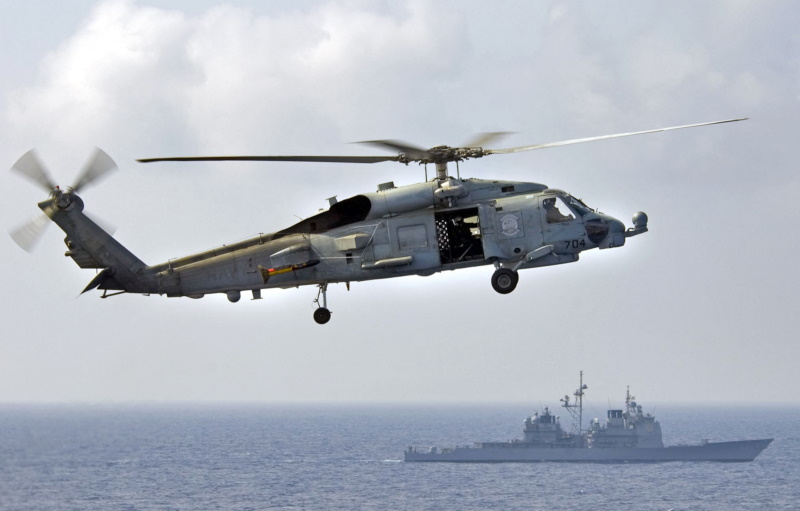
Some of the other changes were more obvious. The most important was the LAMPS electronics suite, which included:
There was a stub pylon behind the cabin door on each side for carriage of a total of two Mark 46 homing torpedoes or two 455-liter (120 US gallon) external fuel tanks.
The fact that the Seahawk had a bigger kit of built-in gear made its empty weight substantially greater than that of the UH-60A -- 6,190 kilograms (13,650 pounds) versus 4,820 kilograms (10,625 pounds). The Seahawk's maximum take-off weight was also greater, at 9,925 kilograms (21,885 pounds), compared to the UH-60A's 9,185 kilograms (20,250 pounds). The Seahawk was originally fitted with uprated GE T700-GE-401 turboshafts, with 1,260 kW (1,690 SHP) each, to handle the greater weight; the engines were corrosion-protected for maritime operation. The UH-60A's transmission system was uprated to handle the more powerful engines. The engines were later upgraded to T700-GE-401Cs with 1,420 kW (1,900 SHP) each. Top speed was lower due to the heavier weight and greater external clutter of the Seahawk.
The Seahawk's landing gear was its most obvious distinguishing element. It featured a two-wheel tailwheel, moved forward to the rear of the main fuselage, and taller main gear to provide clearance for the drum radome. The landing gear was simplified compared to the UH-60A, since the heavy-duty shock absorber system of the Army version was judged unnecessary. The window and door arrangement was also substantially modified, with the door on the left eliminated and the door on the right reduced in size.
Three crew were normally carried, including a pilot, a copilot / airborne tactical officer, and sensor operator or "senso". Most of the data was transferred to the parent vessel for processing, but the crew handled the terminal attack themselves. The Seahawk could be fitted with an external rescue hoist on the right side to support its secondary SAR role, as well as a belly cargo sling hook for "vertical replenishment (vertrep)" missions.
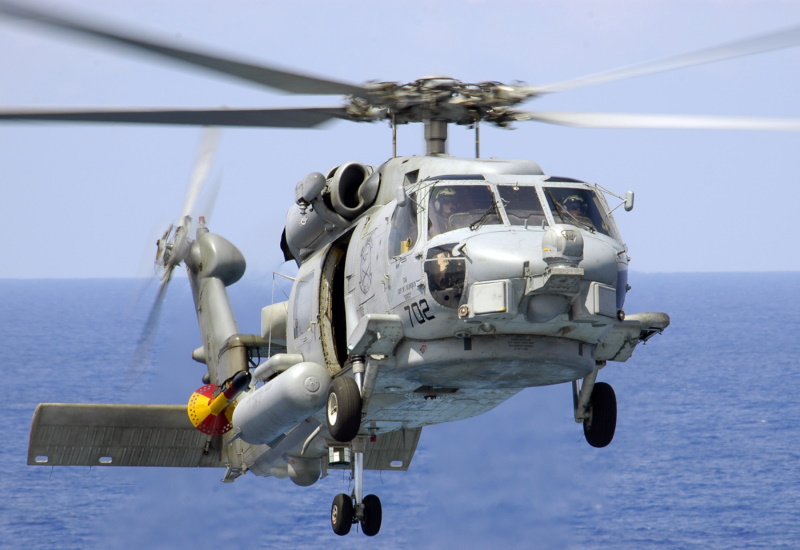
* A total of 181 SH-60Bs was built, not counting the five prototypes. During operations in the Persian Gulf from 1987, a total of 25 SH-60Bs were fitted with countermeasures and other enhancements under the "Middle East Force Modification (MEF-MOD)" program, which included:
The Seahawk served with distinction in the Gulf War, flying boarding parties to support blockade operations; flying mine patrols; performing CSAR operations, rescuing an F-16 and an AV-8B pilot; transporting SEAL teams on special operations; and providing defensive sensors for US Navy surface elements. Seahawks carried an oversized chaff round named an AIRBOC that was ejected from a sonobuoy tube, providing a heavy cloud of chaff to frustrate Iraqi antiship missiles, which actually did not turn out to be much of a threat.
Even before the Gulf War, a "Block I" SH-60B upgrade was underway, featuring avionics enhancements such as a GPS navigation receiver and dual MIL-STD 1553B digital avionics buses; provision for mounting a GECAL 50 12.7-millimeter machine gun; and support for the AGM-199B Mark 2 Mod 7 Penguin antiship missile and the improved "Mark 50 Barracuda" torpedo, which could dive deeper and had a smarter seeker than the older Mark 46. The Mark 50 torpedo turned out to be too expensive, however, and so the Navy decided to adopt the "Mark 54", a modernized Mark 46, instead. The left stub stores pylon was extended to allow carriage of an external fuel tank, along with the traditional two stores. The right stub pylon could not be extended, since it would get in the way of the rescue hoist. The SH-60B was finally retired from US Navy service in 2015, being replaced by the MH-60R variant -- see below.
BACK_TO_TOP* The US Navy acquired another version of the S-70B for close-in carrier group antisubmarine warfare, with this variant designated the "SH-60F Ocean Hawk". The Ocean Hawk deleted the RAST gear, which wasn't required since the SH-60F operated off carrier decks, and replaced the LAMPS III suite with a much less elaborate offensive avionics suite, centered around a Bendix AN/AQS-13F dipping sonar. Radar, ESM, and the datalink were deleted. The sonobuoy array was deleted, but there was a sonobuoy tube in the floor of the cabin, and a rack was included for of eight sonobuoys that could be dropped manually through the tube.
In addition, the SH-60F had a wider left stores pylon, allowing the helicopter to carry a total of three Mark 50 homing torpedoes, or two torpedoes and an external fuel tank. The SH-60F had a sling hook to allow it to perform vertrep duties.
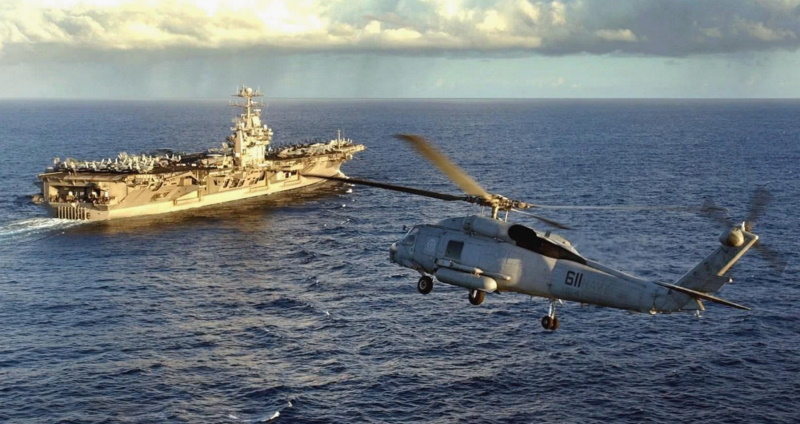
Another one of the Ocean Hawk's duties was to serve as a "plane guard", standing by during carrier takeoff and recovery operations to pick up pilots who end up in the drink. It was fitted with a rescue hoist on the right side for this role. Initial flight of an SH-60F was on 19 March 1987, with the type going into service in 1991, just in time for Gulf War service. The last of 82 production SH-60Fs was delivered in 1994. They were finally retired in 2016, also being replaced by the MH-60R.
* The Navy used the S-70B airframe as the basis for its own covert operations / CSAR variant, the "HH-60H Rescue Hawk". Unlike its Army and Air Force counterparts, it did not have an inflight refueling probe, though it could be fitted with external tanks. It did have:
Of course, the Rescue Hawk had an external rescue hoist on the right side of the machine. A 7.62-millimeter M-60D machine gun was originally fitted on a pintle mount in each door -- the HH-60H had doors on each side, and no forward window in which to mount a gun -- but these were upgraded to more potent GECAL 12.7-millimeter machine guns. Initial flight of the HH-60H prototype was on 17 August 1988, with initial service deliveries in 1989. A total of 42 Rescue Hawks was obtained, with last delivery in 1996. They were retired in 2019.
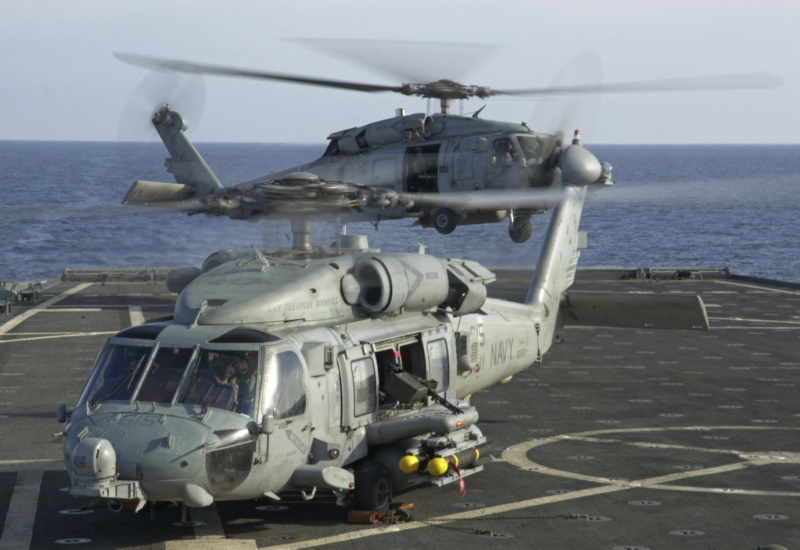
* The US Coast Guard ordered a SAR variant, designated the "SH-60J Jayhawk" or "Medium Range Recovery (MRR)" helicopter, which could be described generally as a Rescue Hawk stripped of combat gear such as HIRSS exhaust suppressors and defensive countermeasures, and of course armament such as torpedoes and heavy machine guns. It retained the stub pylon arrangement of the Rescue Hawk to carry up to three external tanks, and RAST gear could be fitted for operation off of larger USCG cutters.
The Jayhawk was equipped with a Bendix-King RDR-1300 search and weather radar in a thimble radome on the nose, and also had a radio direction finder and an ILS/VOR landing/navigation receiver. It had an external hoist, on the right side of the fuselage and with a load capacity of 272 kilograms (600 pounds), could carry a searchlight, and the cockpit was NVG compatible. Four crew were carried, including pilot, copilot, flight engineer / hoist operator, and rescue swimmer. When fitted with three 455-liter (120 US gallon) external tanks, the Jayhawk had an operational radius of 480 kilometers (300 miles), an endurance of 45 minutes at that radius, and a capacity of six passengers on the return flight.
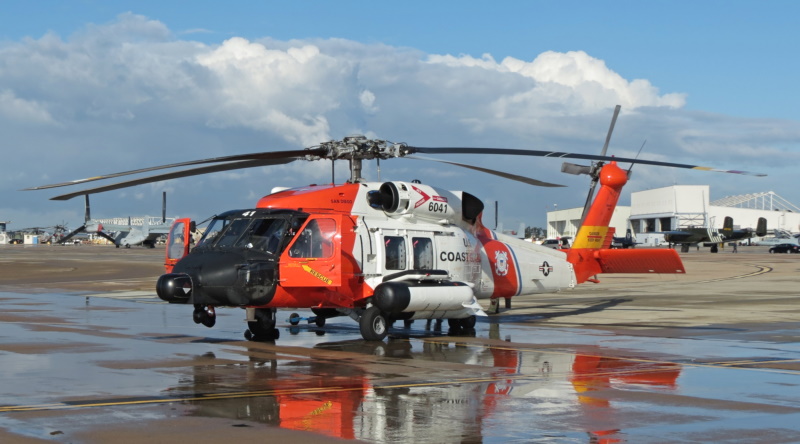
Sikorsky received a contract for the type in September 1986. Initial flight of the Jayhawk prototype was on 8 August 1990, with the type going into service in July 1991. In October, USCG Jayhawks made headlines by rescuing nine crew from the 106-year-old schooner ANNE KRISTINE in storm conditions, and then rescuing four people off a pleasure boat the next day.
42 production machines were delivered, painted in bright, high gloss orange-red and white "creamsicle" colors that immediately announce the type as "US Coast Guard" at first glance. While its primary mission is SAR, it is also used in law enforcement, environmental protection, and drug interdiction roles. A number of Jayhawks have been armed with light machine guns and M-14 sniper rifles to deal with drug-running "go-fast" boats; these machines are designated "MH-60J".
After the turn of the century, the Coast Guard began a modernization program for their Jayhawks to bring them up to the "MH-60T" standard, featuring an airframe service-life extension, improved engines, a new cockpit, improved radar, and modernized electro-optic / infrared imagers. All have armament capability. The first MH-60T conversion was rolled out in 2008, with the variant's introduction to service in 2009. 39 machines were upgraded, the last being redelivered in 2014. Three retired SH-60F Seahawks were updated to MH-60T standard from 2010, it appears as attrition replacements, fleet strength remaining at 42.
A follow-on service-life extension program is planned, the intent being to keep the Jayhawks in service to 2030 or later. Some of the retired Navy HH-60Hs are to be converted to MH-60T standard.
BACK_TO_TOP* The Seahawk having proven effective, the US Navy eventually decided to eliminate seven different types of helicopters to standardize on two: the "MH-60R Multi-Mission Helicopter (MMH)" and the "MH-60S Knighthawk".
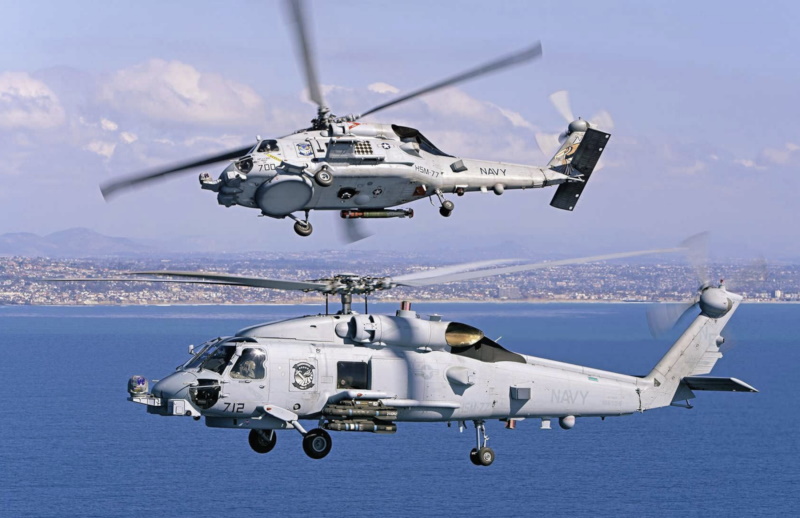
The MH-60R, which was called the "Strikehawk" early on, replaced the SH-60B and SH-60F. It used the S-70B airframe, but featured improvements including a state-of-the-art glass cockpit with four 20 by 25 centimeter (8 by 10 inch) color flat panel displays and dual GPS navigation systems; plus a modernized cabin layout with a stronger floor. The glass cockpit permitted any of the three crew to interface with the system and perform any action. Operational avionics were fully updated, featuring:
The tailwheel was moved forward slightly to improve deck handling. It had four stores attachments. Armament included homing torpedoes; Penguin, Hellfire, or APKWS missiles; plus door-mounted 12.7-millimeter or 7.62-millimeter machine guns.
The first test machine performed its initial flight in July 2001, with three test machines delivered to the Navy in that year. The initial production item was delivered in August 2005. 280 MH-60Rs were delivered to the US Navy in 2018, with eight more delivered in 2019. Although the initial test and low-rate production machines were rebuilds, the full production machines were all new-build rotorcraft.
* The MH-60S Knighthawk was a departure from the S-70B line, being based on the S-70 / UH-60L airframe. The reason for the switch was that the primary focus of the MH-60S was seen as the utility transport role -- as its initial designation of "CH-60S" suggested -- and not the maritime warfare role. At the outset, the MH-60S was seen as a replacement for the Navy's Boeing CH-46 Sea Knight, which is likely where the "Knighthawk" name came from, but the scope of the effort expanded, and in fact the MH-60S was just as much a "multi-mission" machine as the MH-60R MMH; it's just that the sets of missions were different.
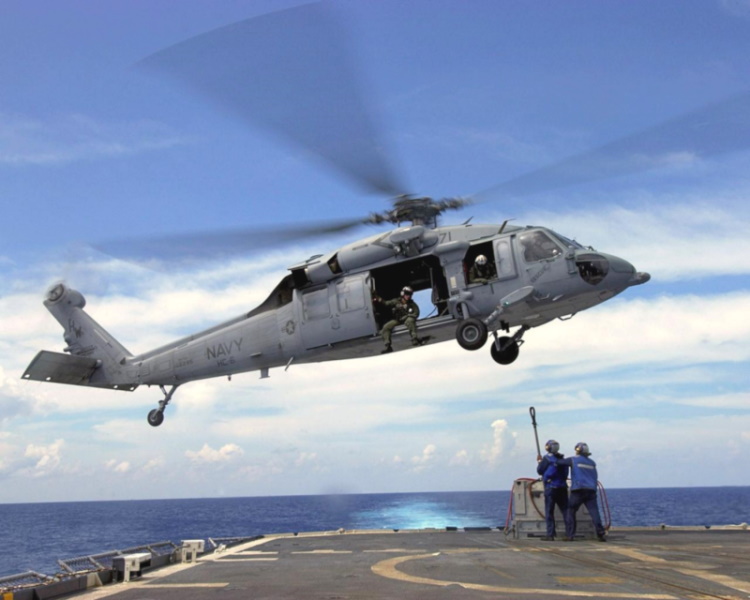
The MH-60S was intended to not only replace the CH-46 Sea Knight in the utility transport role, but to operate in the CSAR / special operations role as a replacement for the Navy HH-60H Rescue Hawk, and in the mine countermeasures role to replace the Sikorsky CH-53E Sea Dragon. Although the Navy originally thought of refurbishing old S-70Bs for the program, mission creep meant that the price of refurbishing floated up towards the price of new machines, until it made more sense to "buy new".
As noted, the MH-60S looked more like a Black Hawk than a Seahawk; it featured:
However, the MH-60S was a hybrid, featuring a large amount of kit from the SH-60B Seahawk, including:
The MH-60S also featured the new glass cockpit of the MH-60R, plus a new cargo handling system. It could be armed with twin pintle-mounted machine guns and the ESSS pylons; possible stores included any that an MH-60R could carry -- except for homing torpedoes and antiship missiles, the Sierra didn't have the ability to target them itself.
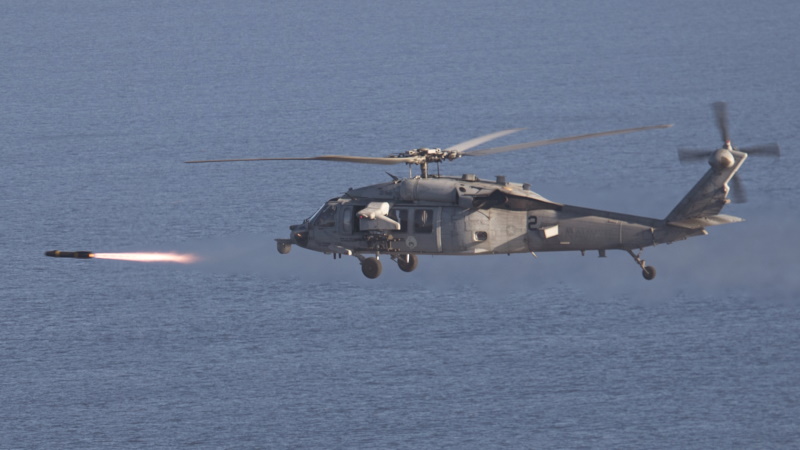
A field kit provided:
Updated with the field kit, the MH-60S could be used for naval surface warfare. A kit was also defined for the mine countermeasures role, consisting of five mine-sweeping systems:
The kit included a tow and recovery system to handle the towed units. Helicopter control and display systems were modified to handle the mine-sweeping systems.
Both the MH-60R and MH-60S were qualified to carry the Lockheed Martin "AN/ALQ-248 Advanced Offboard Electronic Warfare (AOEW)" pod. The AN/ALGQ-248 was designed to defend fleet surface elements from antiship missiles, with both detection and countermeasures capability -- presumably detecting an antiship missile from the emissions of its radar seeker, and then jamming the seeker emissions. It included a Link-16 datalink to interact with other naval and air assets.
The Navy awarded Sikorsky a contract to begin formal development of what would become the MH-60S in 1997, with the first production machine performing its initial flight in January 2000. A batch of 30 low-rate production machines followed, leading to service entry in February 2002 and commitment to full-rate production in August 2002. 267 MH-60S Knighthawks will be purchased in all. Navy CH-46 Sea Knights were replaced in service by Knighthawks, with full retirement of the Sea Knight in 2004.
With the MH-60R and MH-60S both now in widespread service, the USN is already considering upgrades, with an assessment to be performed on both rotorcraft to the end of this decade. Those assessments will lead to definition of an upgrade program, to be implemented from the middle of the next decade. Presumably, one of the options to be considered will be marinized GE T901 engines.
BACK_TO_TOP* Although the Seahawk has not been exported in near the numbers of the Black Hawk, there are still a number of foreign users. The Royal Australian Navy (RAN) acquired 16 "S-70B-2" machines, featuring an S-70B airframe and RAN-specified avionics. The avionics suite included:
The RAN S-70B-2s could carry Penguin or Sea Skua light antishipping missiles, and were fitted with a rescue hoist on the right side. Eight S-70B-2s were supplied directly by Sikorsky, and eight more were supplied as kits for assembly by ASTA in Australia. Some of the RAN Seahawks saw action in the Gulf War, these machines being fitted with an AN/AAQ-16 FLIR turret and an AN/AAR-47 missile warning system. The fleet was given a midlife update in 2004:2005.
In 2011, Australia became the first export buyer for the MH-60R Strikehawk, obtained for operation from RAN frigates. The first of 24 was delivered in 2014, with introduction to service in 2015, and final deliveries in 2016. A program was initiated in 2016 to bring the MH-60Rs up to current spec. The earlier S-70B-2s in RAN service were retired in 2017. Most were sold to an Australian air charter company, being stripped of combat systems. 13 more MH-60Rs were ordered in 2022, one being an attrition replacement, with initial deliveries in 2025.
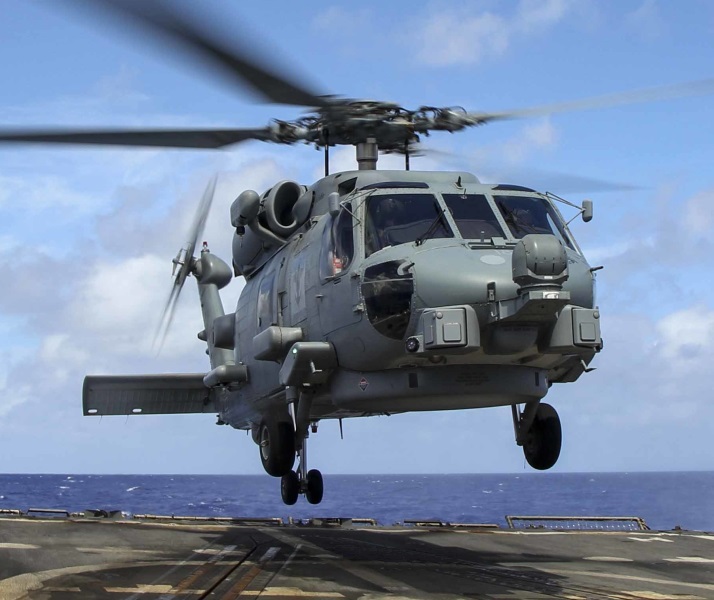
* Denmark followed with an order in 2012 for nine MH-60Rs, to replace old Danish Westland Lynx helicopters, with deliveries from 2016 to 2018. They had minor enhancements, such as cable cutters, an automatically-deploying life raft, and an extra window / emergency exit.
* The Japanese Maritime Self-Defense Force acquired their own version of the SH-60B, license-built in Japan by Mitsubishi and of course designated "SH-60J", to replace license-built HSS-2B Sea Kings in JMSDF service. The SH-60J, which had the Sikorsky company designation of "S-70B-3", had a configuration and capabilities similar to that of its SH-60B parent, but the avionics suite of the SH-60J was mostly Japanese-built. Japanese kit included:
US-built kit included:
The SH-60J did not have the SH-60B's 25-tube sonobuoy array, and presumably features a sonobuoy tube in the belly as fitted on the SH-60F. Production machines were powered by Ishikawajima-Harima T700-IHI-401C turboshafts, built under license from GE.
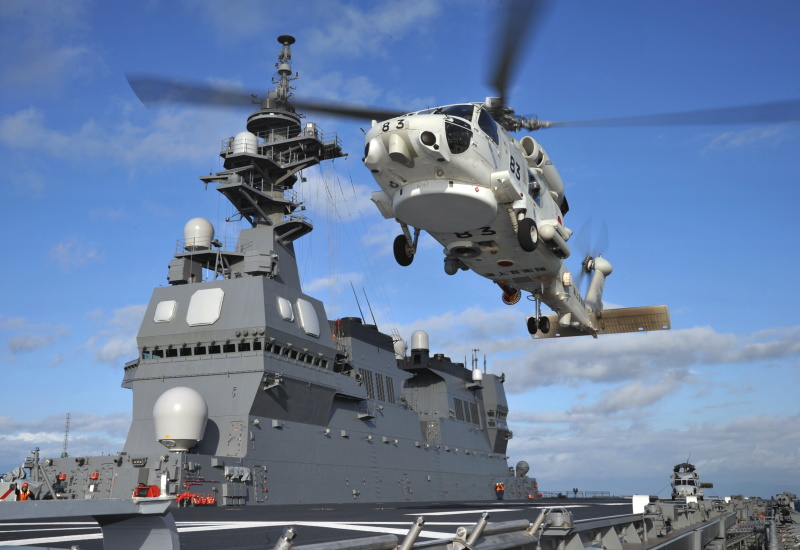
The initial two "XSH-60J" prototypes were delivered in stripped and broken-down form to be reassembled by Mitsubishi and fitted up with avionics systems. Initial flight of the first XSH-60J was on 31 August 1987, and the two prototypes were put through evaluation by the JMSDF. 101 production SH-60Js were ordered, with the first performing its initial flight on 10 May 1991, and delivery to the JMSDF late that summer.
On 8 August 2001, Mitsubishi conducted the initial flight of the first of two prototypes of an upgraded version of the SH-60J designated the "SH-60K", originally the "SH-60J Kai", where "kai" was short for "kaizen (modified)". It had a main cabin stretched by 33 centimeters (13 inches) just behind the cockpit and raised in height, with the expansion intended to accommodate a substantially revised avionics system, including a datalink. Other new features included:
Initial delivery was in 2005. 50 SH-60Ks were ordered, all being new production machines. An upgrade program for the SH-60Ks was begun in 2015, with the first upgrade flying in 2021. Details of the upgrade were not announced.
* Taiwan obtained ten "S-70C(M)-1 Thunderhawks" similar to the SH-60F Ocean Hawk, featuring:
A second batch of 11 "S-70C(M)-2" machines of similar configuration followed, these machines being operated off Taiwanese guided missile frigates. The "S-70C" designation, meaning a commercial S-70, was clearly a political dodge.
Other Seahawk users included:
* The second production SH-60F was used for trials and ultimately was converted into a demonstrator for a high-speed "compound helicopter" derivative of the S-70, the Piasecki "X-49A Speedhawk". The program was initiated by the Navy but passed over to the Army in 2003. Initial flight was in 2007.
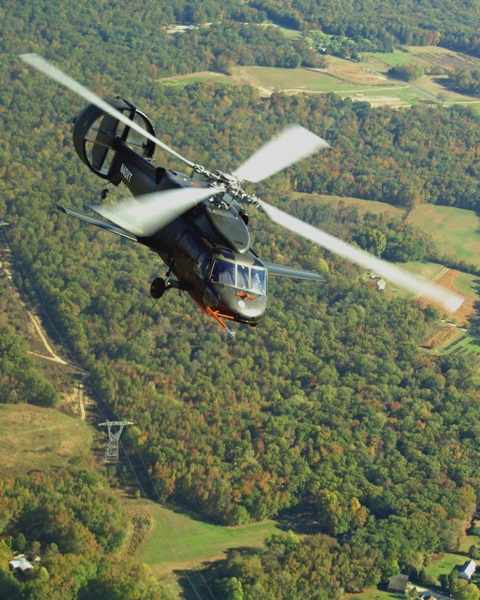
The Speedhawk featured a set of wings, obtained from a business jet, and the tail modified into a ring-tail pusher-prop configuration; torque was handled by a bias on a rudder behind the wing. It was almost 50% faster than a Seahawk in level flight even though it had the same engines, though it did require about 10% more power for hovers, due to the masking effects of the wings. The program was strictly a demonstration; it did not lead to a production machine.
* The Black Hawk / Seahawk is still in its prime, but it will need to be replaced in service from 2030. As mentioned previously, the US Army is working on a set of Future Vertical Lift programs to develop the next generation of rotorcraft, with a Black Hawk replacement being pursued under the "Future Long-Range Assault Aircraft (FLRAA) program, these machines to feature much better performance and improved technology. At present, the Army is investigating two FLRAA solutions:
The US Navy -- and the US Marines -- are interested in FVL, with the Navy working on an FVL "Maritime Strike (MS)" effort to replace the MH-60R/S. FVL-MS is not as far along as FLRAA; both Sikorsky-Boeing and Bell have proposed navalized versions of their FLRAA proposals, but it remains up in the air. Nothing is really nailed down in FVL yet, and won't be for some number of years, so it's best to wait and see.
* Sources include:
* Illustrations details:
v1.0.0 / 01 oct 03 v1.0.1 / 01 aug 04 / Review & polish. v1.0.2 / 01 jul 06 / Review & polish. v2.0.0 / 01 apr 09 / Thorough cleanup. v2.1.0 / 01 mar 11 / Trimmed back on foreign users. v2.1.1 / 01 feb 13 / Review & polish. v2.1.2 / 01 aug 14 / Optionally piloted Black Hawk, Turkish T-70 builds. v2.1.3 / 01 jul 16 / Review, update, & polish. v2.2.0 / 01 jun 18 / Review, many updates, & polish. v2.3.0 / 01 may 20 / Many updates, new illustrations. v2.4.0 / 01 jun 21 / Review, polish, & update. v2.5.0 / 01 jun 23 / Detailed foreign Black Hawk users. (+)BACK_TO_TOP
